KIA SPORTAGE 2021 User Guide
Manufacturer: KIA, Model Year: 2021, Model line: SPORTAGE, Model: KIA SPORTAGE 2021Pages: 631, PDF Size: 10.56 MB
Page 11 of 631
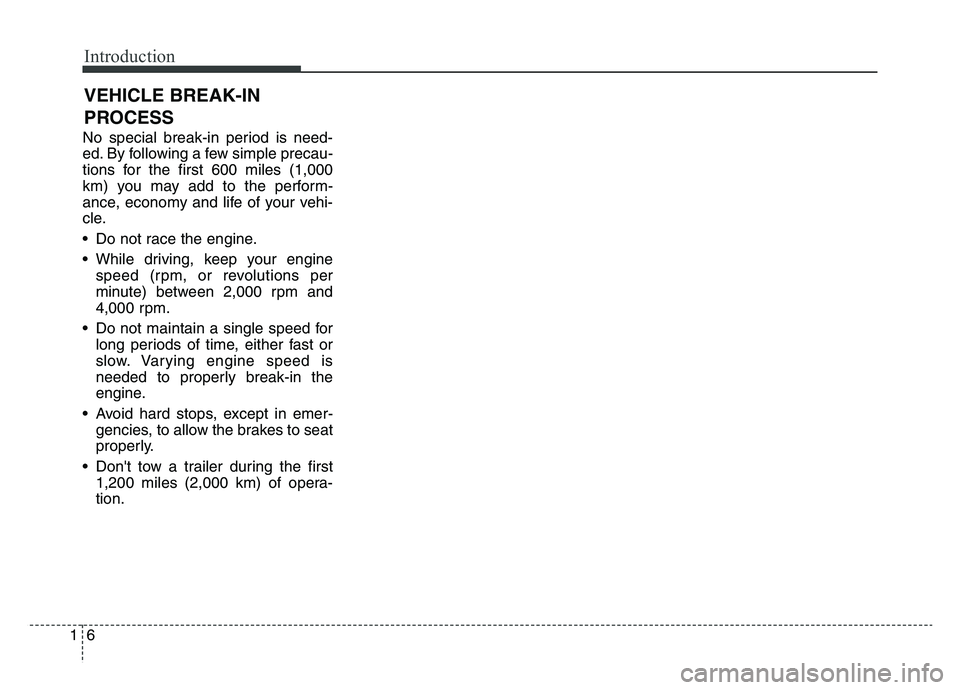
Introduction
61
No special break-in period is need-
ed. By following a few simple precau-
tions for the first 600 miles (1,000
km) you may add to the perform-
ance, economy and life of your vehi-
cle.
• Do not race the engine.
• While driving, keep your enginespeed (rpm, or revolutions per
minute) between 2,000 rpm and
4,000 rpm.
• Do not maintain a single speed for long periods of time, either fast or
slow. Varying engine speed is
needed to properly break-in the
engine.
• Avoid hard stops, except in emer- gencies, to allow the brakes to seat
properly.
• Don't tow a trailer during the first 1,200 miles (2,000 km) of opera-
tion.
VEHICLE BREAK-IN
PROCESS
Page 12 of 631
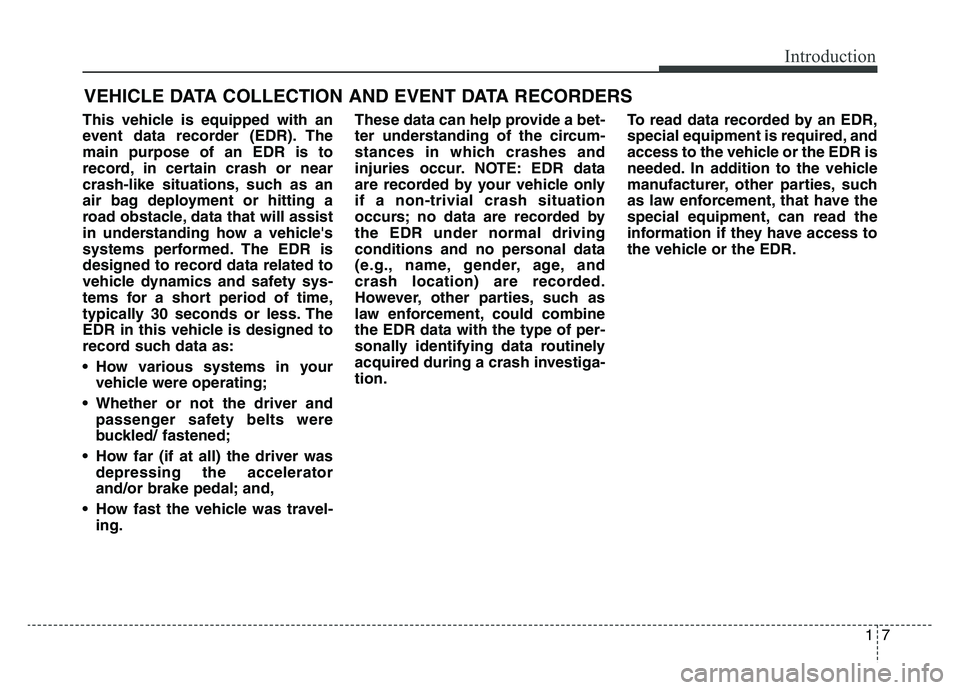
17
Introduction
This vehicle is equipped with an
event data recorder (EDR). The
main purpose of an EDR is to
record, in certain crash or near
crash-like situations, such as an
air bag deployment or hitting a
road obstacle, data that will assist
in understanding how a vehicle's
systems performed. The EDR is
designed to record data related to
vehicle dynamics and safety sys-
tems for a short period of time,
typically 30 seconds or less. The
EDR in this vehicle is designed to
record such data as:
• How various systems in yourvehicle were operating;
• Whether or not the driver and passenger safety belts were
buckled/ fastened;
• How far (if at all) the driver was depressing the accelerator
and/or brake pedal; and,
• How fast the vehicle was travel- ing. These data can help provide a bet-
ter understanding of the circum-
stances in which crashes and
injuries occur. NOTE: EDR data
are recorded by your vehicle only
if a non-trivial crash situation
occurs; no data are recorded by
the EDR under normal driving
conditions and no personal data
(e.g., name, gender, age, and
crash location) are recorded.
However, other parties, such as
law enforcement, could combine
the EDR data with the type of per-
sonally identifying data routinely
acquired during a crash investiga-
tion.
To read data recorded by an EDR,
special equipment is required, and
access to the vehicle or the EDR is
needed. In addition to the vehicle
manufacturer, other parties, such
as law enforcement, that have the
special equipment, can read the
information if they have access to
the vehicle or the EDR.
VEHICLE DATA COLLECTION AND EVENT DATA RECORDERS
Page 13 of 631
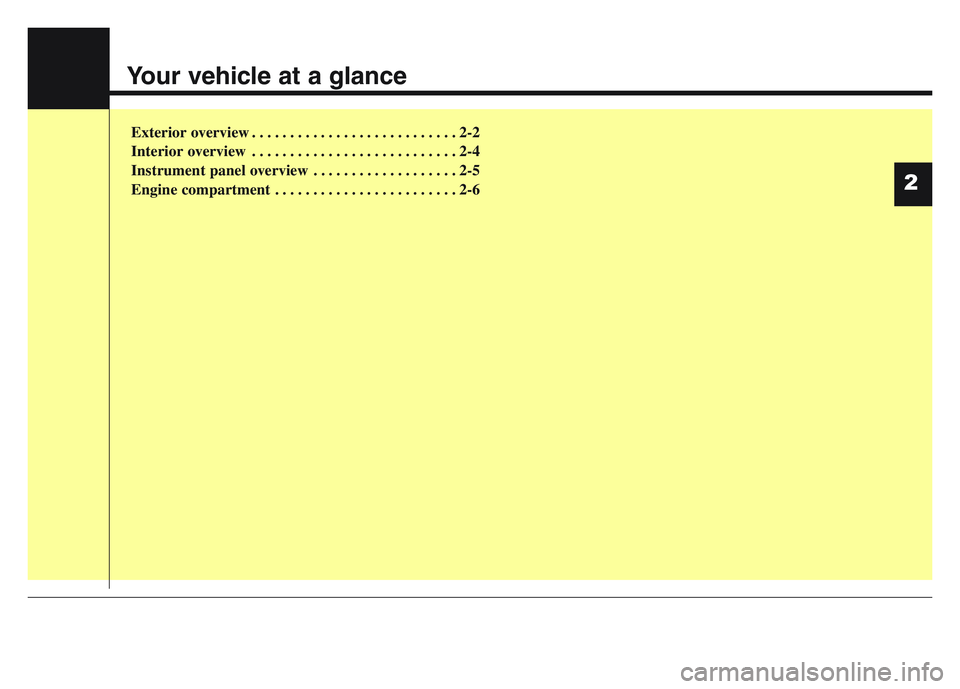
Your vehicle at a glance
Exterior overview . . . . . . . . . . . . . . . . . . . . . . . . . . . 2-2
Interior overview . . . . . . . . . . . . . . . . . . . . . . . . . . . 2-4
Instrument panel overview . . . . . . . . . . . . . . . . . . . 2-5
Engine compartment . . . . . . . . . . . . . . . . . . . . . . . . 2-6
2
Page 14 of 631
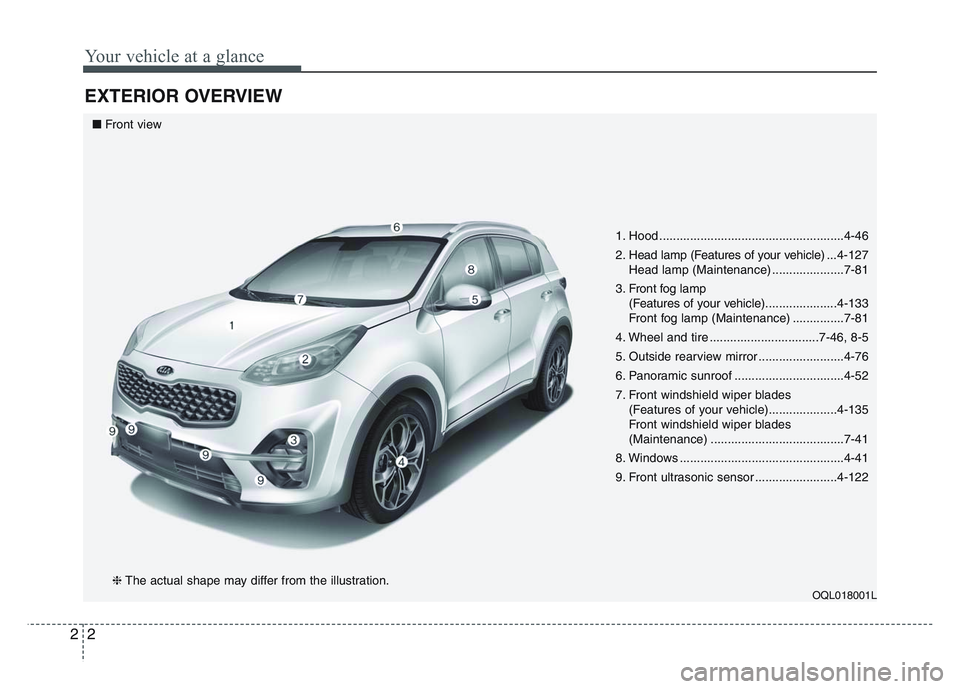
Your vehicle at a glance
22
EXTERIOR OVERVIEW
1. Hood ......................................................4-46
2. Head lamp (Features of your vehicle) ...4-127
Head lamp (Maintenance) .....................7-81
3. Front fog lamp (Features of your vehicle) .....................4-133
Front fog lamp (Maintenance) ...............7-81
4. Wheel and tire ................................7-46, 8-5
5. Outside rearview mirror .........................4-76
6. Panoramic sunroof ................................4-52
7. Front windshield wiper blades (Features of your vehicle)....................4-135
Front windshield wiper blades
(Maintenance) .......................................7-41
8. Windows ................................................4-41
9. Front ultrasonic sensor ........................4-122
OQL018001L
■ Front view
❈ The actual shape may differ from the illustration.
Page 15 of 631
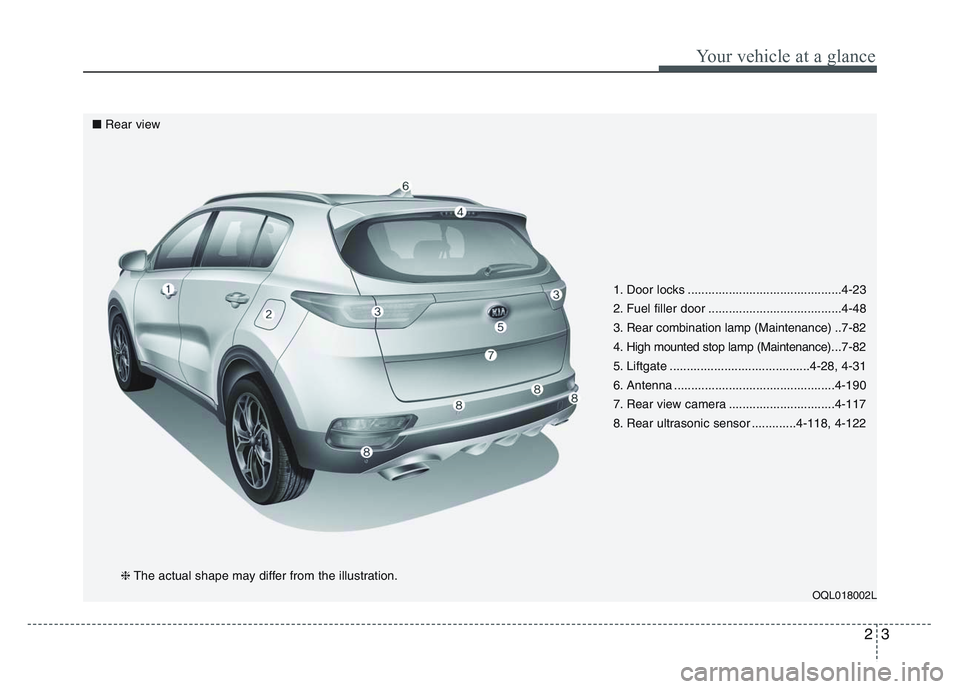
23
Your vehicle at a glance
1. Door locks .............................................4-23
2. Fuel filler door .......................................4-48
3. Rear combination lamp (Maintenance) ..7-82
4. High mounted stop lamp (Maintenance)... 7-82
5. Liftgate .........................................4-28, 4-31
6. Antenna ...............................................4-190
7. Rear view camera ...............................4-117
8. Rear ultrasonic sensor .............4-118, 4-122
OQL018002L
■ Rear view
❈The actual shape may differ from the illustration.
Page 16 of 631
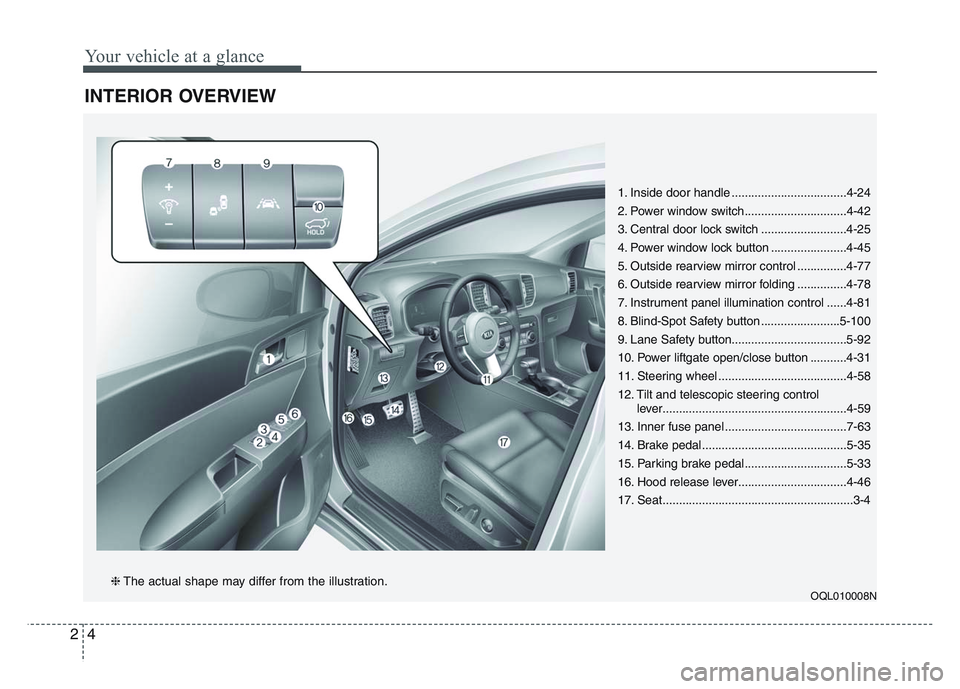
Your vehicle at a glance
42
INTERIOR OVERVIEW
1. Inside door handle ...................................4-24
2. Power window switch...............................4-42
3. Central door lock switch ..........................4-25
4. Power window lock button .......................4-45
5. Outside rearview mirror control ...............4-77
6. Outside rearview mirror folding ...............4-78
7. Instrument panel illumination control ......4-81
8. Blind-Spot Safety button ........................5-100
9. Lane Safety button...................................5-92
10. Power liftgate open/close button ...........4-31
11. Steering wheel .......................................4-58
12. Tilt and telescopic steering controllever........................................................4-59
13. Inner fuse panel .....................................7-63
14. Brake pedal............................................5-35
15. Parking brake pedal...............................5-33
16. Hood release lever.................................4-46
17. Seat..........................................................3-4
OQL010008N❈ The actual shape may differ from the illustration.
Page 17 of 631
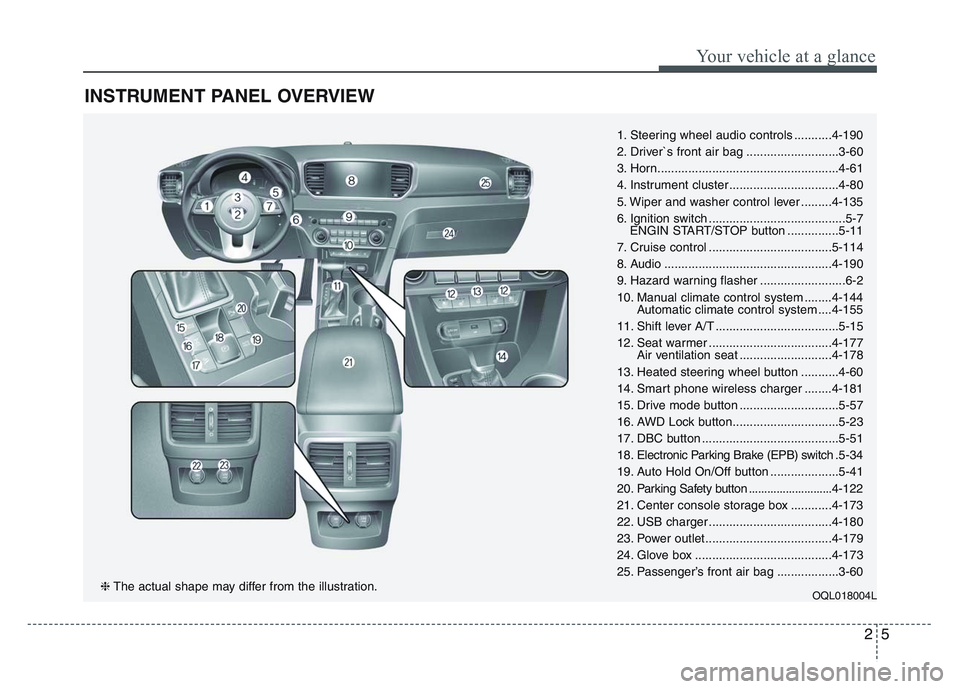
25
Your vehicle at a glance
INSTRUMENT PANEL OVERVIEW
1. Steering wheel audio controls ...........4-190
2. Driver`s front air bag ...........................3-60
3. Horn.....................................................4-61
4. Instrument cluster ................................4-80
5. Wiper and washer control lever .........4-135
6. Ignition switch ........................................5-7ENGIN START/STOP button ...............5-11
7. Cruise control ....................................5-114
8. Audio .................................................4-190
9. Hazard warning flasher .........................6-2
10. Manual climate control system ........4-144 Automatic climate control system ....4-155
11. Shift lever A/T ....................................5-15
12. Seat warmer ....................................4-177 Air ventilation seat ...........................4-178
13. Heated steering wheel button ...........4-60
14. Smart phone wireless charger ........4-181
15. Drive mode button .............................5-57
16. AWD Lock button...............................5-23
17. DBC button ........................................5-51
18. Electronic Parking Brake (EPB) switch .5-34
19. Auto Hold On/Off button ....................5-41
20. Parking Safety button ...........................4-122
21. Center console storage box ............4-173
22. USB charger ....................................4-180
23. Power outlet.....................................4-179
24. Glove box ........................................4-173
25. Passenger’s front air bag ..................3-60
OQL018004L❈ The actual shape may differ from the illustration.
Page 18 of 631
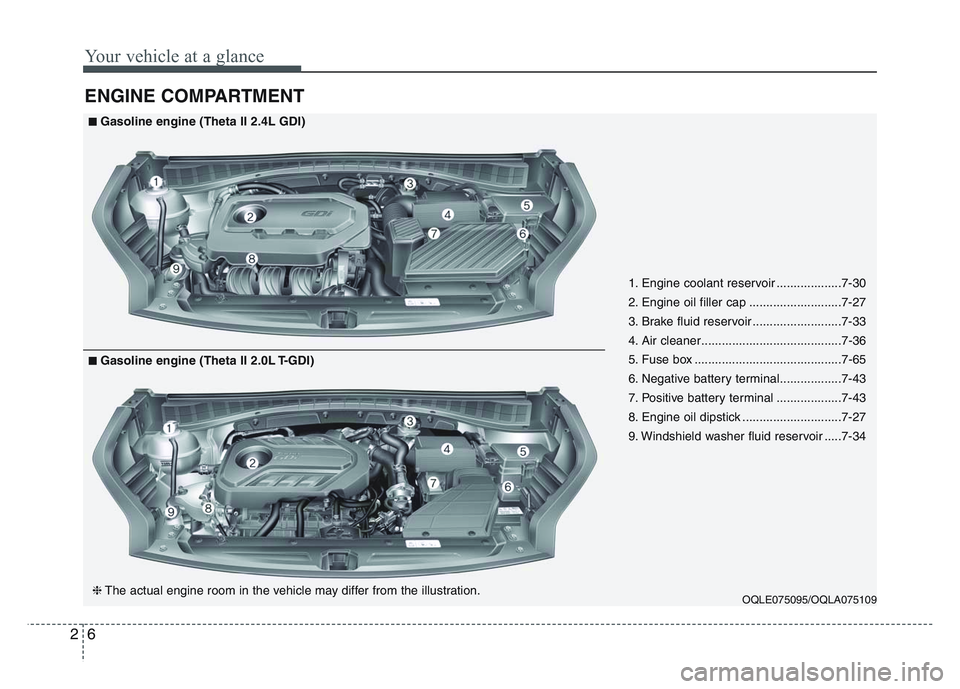
Your vehicle at a glance
62
ENGINE COMPARTMENT
OQLE075095/OQLA075109
■Gasoline engine (Theta II 2.4L GDI)
❈ The actual engine room in the vehicle may differ from the illustration.
■Gasoline engine (Theta II 2.0L T-GDI) 1. Engine coolant reservoir ...................7-30
2. Engine oil filler cap ...........................7-27
3. Brake fluid reservoir ..........................7-33
4. Air cleaner.........................................7-36
5. Fuse box ...........................................7-65
6. Negative battery terminal..................7-43
7. Positive battery terminal ...................7-43
8. Engine oil dipstick .............................7-27
9. Windshield washer fluid reservoir .....7-34
Page 19 of 631
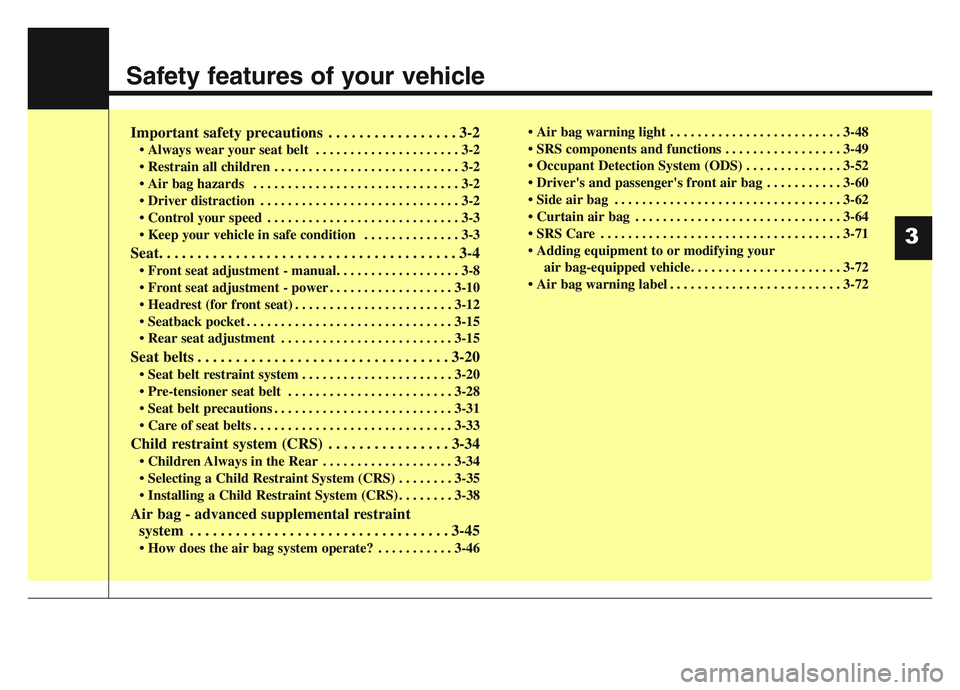
Safety features of your vehicle
Important safety precautions . . . . . . . . . . . . . . . . . 3-2
• Always wear your seat belt . . . . . . . . . . . . . . . . . . . . . 3-2
• Restrain all children . . . . . . . . . . . . . . . . . . . . . . . . . . . 3-2
• Air bag hazards . . . . . . . . . . . . . . . . . . . . . . . . . . . . . . 3-2
• Driver distraction . . . . . . . . . . . . . . . . . . . . . . . . . . . . . 3-2
• Control your speed . . . . . . . . . . . . . . . . . . . . . . . . . . . . 3-3
• Keep your vehicle in safe condition . . . . . . . . . . . . . . 3-3
Seat. . . . . . . . . . . . . . . . . . . . . . . . . . . . . . . . . . . . \
. . . 3-4
• Front seat adjustment - manual. . . . . . . . . . . . . . . . . . 3-8
• Front seat adjustment - power . . . . . . . . . . . . . . . . . . 3-10
• Headrest (for front seat) . . . . . . . . . . . . . . . . . . . . . . . 3-12
• Seatback pocket . . . . . . . . . . . . . . . . . . . . . . . . . . . . . . 3-15
• Rear seat adjustment . . . . . . . . . . . . . . . . . . . . . . . . . 3-15
Seat belts . . . . . . . . . . . . . . . . . . . . . . . . . . . . . . . . . 3-20
• Seat belt restraint system . . . . . . . . . . . . . . . . . . . . . . 3-20
• Pre-tensioner seat belt . . . . . . . . . . . . . . . . . . . . . . . . 3-28
• Seat belt precautions . . . . . . . . . . . . . . . . . . . . . . . . . . 3-31
• Care of seat belts . . . . . . . . . . . . . . . . . . . . . . . . . . . . . 3-33
Child restraint system (CRS) . . . . . . . . . . . . . . . . 3-34
• Children Always in the Rear . . . . . . . . . . . . . . . . . . . 3-34
• Selecting a Child Restraint System (CRS) . . . . . . . . 3-35
• Installing a Child Restraint System (CRS) . . . . . . . . 3-38
Air bag - advanced supplemental restraint system . . . . . . . . . . . . . . . . . . . . . . . . . . . . . . . . . . 3-45\
• How does the air bag system operate? . . . . . . . . . . . 3-46 • Air bag warning light . . . . . . . . . . . . . . . . . . . . . . . . . 3-48
• SRS components and functions . . . . . . . . . . . . . . . . . 3-49
• Occupant Detection System (ODS) . . . . . . . . . . . . . . 3-52
• Driver's and passenger's front air bag . . . . . . . . . . . 3-60
• Side air bag . . . . . . . . . . . . . . . . . . . . . . . . . . . . . . . . . 3-62
• Curtain air bag . . . . . . . . . . . . . . . . . . . . . . . . . . . . . . 3-64
• SRS Care . . . . . . . . . . . . . . . . . . . . . . . . . . . . . . . . . . . 3-\
71
• Adding equipment to or modifying your
air bag-equipped vehicle. . . . . . . . . . . . . . . . . . . . . . 3-72
• Air bag warning label . . . . . . . . . . . . . . . . . . . . . . . . . 3-72
3
Page 20 of 631
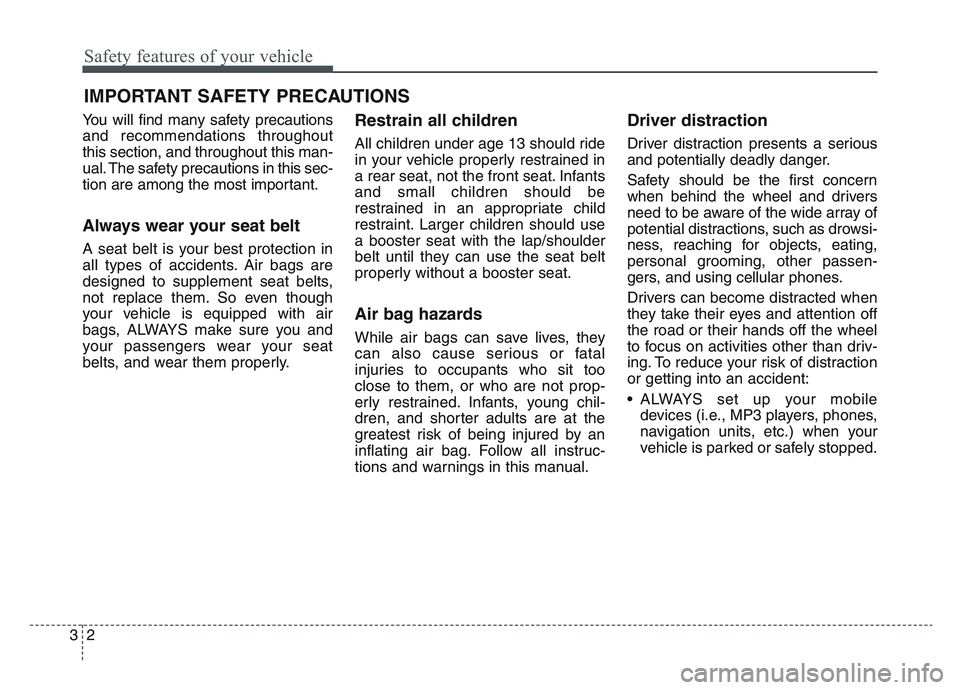
Safety features of your vehicle
23
You will find many safety precautions
and recommendations throughout
this section, and throughout this man-
ual. The safety precautions in this sec-
tion are among the most important.
Always wear your seat belt
A seat belt is your best protection in
all types of accidents. Air bags are
designed to supplement seat belts,
not replace them. So even though
your vehicle is equipped with air
bags, ALWAYS make sure you and
your passengers wear your seat
belts, and wear them properly.
Restrain all children
All children under age 13 should ride
in your vehicle properly restrained in
a rear seat, not the front seat. Infants
and small children should be
restrained in an appropriate child
restraint. Larger children should use
a booster seat with the lap/shoulder
belt until they can use the seat belt
properly without a booster seat.
Air bag hazards
While air bags can save lives, they
can also cause serious or fatal
injuries to occupants who sit too
close to them, or who are not prop-
erly restrained. Infants, young chil-
dren, and shorter adults are at the
greatest risk of being injured by an
inflating air bag. Follow all instruc-
tions and warnings in this manual.
Driver distraction
Driver distraction presents a serious
and potentially deadly danger.
Safety should be the first concern
when behind the wheel and drivers
need to be aware of the wide array of
potential distractions, such as drowsi-
ness, reaching for objects, eating,
personal grooming, other passen-
gers, and using cellular phones.
Drivers can become distracted when
they take their eyes and attention off
the road or their hands off the wheel
to focus on activities other than driv-
ing. To reduce your risk of distraction
or getting into an accident:
• ALWAYS set up your mobiledevices (i.e., MP3 players, phones,
navigation units, etc.) when your
vehicle is parked or safely stopped.
IMPORTANT SAFETY PRECAUTIONS